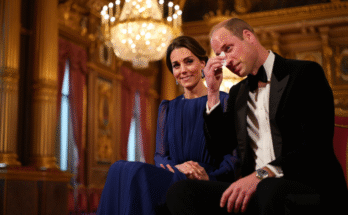Maddow, Colbert, and Kimmel Shake the Media World With Surprise Independent Newsroom Launch
In a move that has sent shockwaves across the media landscape, three of America’s most recognizable television figures—Rachel Maddow, Stephen Colbert, and Jimmy Kimmel—have made the bold decision to walk away from their long-established network contracts to launch an independent newsroom. The announcement, released simultaneously across their social media platforms on Friday morning, has left the television and journalism industries reeling and audiences buzzing about what this could mean for the future of news.
The trio’s stated mission is ambitious: dismantle the walls of corporate media, challenge authority without compromise, and “restore real journalism” to a public sphere increasingly skeptical of traditional outlets. Within hours of the announcement, hashtags like #MediaRevolution and #IndependentNewsroom were trending across Twitter, Instagram, and TikTok, garnering millions of mentions and sparking widespread discussion.

“This is not about leaving television,” Maddow explained in a joint video message. “It’s about creating a space where journalism doesn’t have to pass through corporate filters, advertiser approval, or political influence. It’s about truth—unvarnished, unapologetic truth.”
A Stunning Break from the Networks
Each of the three stars had cultivated impressive careers within traditional broadcast networks. Maddow, MSNBC’s leading anchor, had earned a reputation as one of the most incisive political commentators on television. Colbert, CBS’s late-night powerhouse, consistently pulled strong ratings against competitors like Jimmy Fallon and Seth Meyers, while Kimmel had become a cultural institution after two decades at ABC’s Jimmy Kimmel Live!
Leaving these lucrative platforms—along with the multimillion-dollar contracts that accompanied them—was almost unthinkable. Yet the trio insists that the corporate media system had become unsustainable. “We spent years being told to soften the edges,” Colbert noted in a statement. “To make sure advertisers weren’t spooked, to ensure executives could still shake hands at cocktail parties in D.C. and Manhattan. That isn’t journalism. That’s marketing.”
The Birth of “The Independent Newsroom”
The new venture, simply named The Independent Newsroom, is designed as a subscription-based digital platform that promises in-depth investigative reporting, daily commentary, and live-streamed panel discussions. Maddow, Colbert, and Kimmel emphasized that there will be no corporate advertisers influencing content—funding will come solely from subscriptions, grants, and crowdfunding.
According to a press release, the newsroom will debut with a team of 25 journalists, producers, and satirists, many of whom previously worked for major outlets including CNN, The New York Times, and even Fox News. Kimmel described the initiative as “equal parts watchdog and court jester.” “We’ll dig into the documents and the data, but we’ll also skew the absurdity of power,” he said. “You can’t take on corruption without humor—it’s what keeps people sane.”
Industry analysts are already describing the launch as a “seismic disruption” in the media world. By combining Maddow’s investigative gravitas, Colbert’s sharp satirical wit, and Kimmel’s populist late-night appeal, The Independent Newsroom could rapidly attract an audience disillusioned with both mainstream news and partisan echo chambers.
A Cultural Expert Weighs In
“Think about it,” said Dr. Evelyn Carter, a professor of media studies at Columbia University. “They’re taking three of the biggest television brands and fusing them into a single entity that has zero corporate oversight. It’s like Netflix, ProPublica, and The Daily Show had a baby.”

Critics, however, caution that the venture could struggle without the deep pockets of traditional networks. Sustaining high-quality investigative journalism requires considerable funding, and subscriptions alone may not be enough to keep operations viable. “They’ll need millions in subscriptions just to break even,” warned an anonymous media executive. “And Americans aren’t exactly rushing to pay for news.”
Rival Networks Respond
Unsurprisingly, competitors have wasted no time reacting. Fox News anchors mocked the launch, with Greg Gutfeld quipping, “Three overpaid talkers finally discovered Substack. Congratulations.” Tucker Carlson, now running his own independent show on X, dismissed the move as “too little, too late.”
MSNBC released a brief statement thanking Maddow for her years of service, while CBS expressed “disappointment” at Colbert’s departure. ABC, still processing Kimmel’s exit, declined to comment. Behind the scenes, insiders report a near-panic atmosphere in some newsrooms. “If this experiment works, it could break the networks’ monopoly on trust,” said an NBC producer. “It would prove you don’t need the old institutions anymore. That’s terrifying for them.”
The Public Reacts
Social media, by contrast, has largely celebrated the trio’s independence. Within 24 hours, The Independent Newsroom’s pre-registration site reportedly crashed from overwhelming traffic. Early subscribers flooded Twitter with praise, calling the venture “the revolution we’ve been waiting for.”
Skeptics remain, however, questioning whether the newsroom could devolve into another partisan echo chamber. “I don’t need more partisan comedy—I need facts,” one user tweeted. Yet the level of attention indicates that Maddow, Colbert, and Kimmel have tapped into widespread frustration with traditional media institutions.
Inside the First Projects
While details remain tightly guarded, sources indicate the newsroom’s first investigative series will examine corporate lobbying in Washington. Another project reportedly explores Silicon Valley tech money’s influence on both political parties. Maddow is set to lead the investigative unit, while Colbert and Kimmel will co-host a nightly satirical broadcast blending sketches, interviews, and live news analysis.
“They’re trying to reinvent the town square,” said media critic Howard Stein. “Imagine watching a comedy sketch about the debt ceiling, then flipping directly into a hard-hitting investigation about campaign finance. That’s what they’re aiming for.”
A Larger Cultural Shift
Experts suggest this move represents more than just a new platform; it reflects a broader cultural shift away from centralized media power. With the rise of YouTube creators, podcasts, and independent Substack publications, network television has been gradually losing its dominance. By leveraging their personal brands, Maddow, Colbert, and Kimmel could rebuild trust one subscriber at a time.
The Risks Ahead
Despite the excitement, the risks are significant. Without advertiser dollars, sustaining an investigative newsroom could require constant fundraising. Additionally, with three strong personalities at the helm, internal ideological clashes could arise. “Unions, politics, content strategy—it’s going to get messy fast,” Stein noted. “But messy doesn’t mean doomed. Sometimes messy is exactly what America needs.”

The Spark of Something New
Whether The Independent Newsroom becomes a fleeting experiment or the foundation of a new media revolution remains uncertain. What is clear is that Maddow, Colbert, and Kimmel have responded to a hunger for journalism outside the bounds of corporate influence.
“They thought we’d be afraid to leave,” Colbert said during the announcement. “They thought the machine was too powerful. But machines only work when people feed them. We’re done feeding it.”
As the trio prepares to launch their first broadcasts next month, the media world is left to ponder: is this the beginning of the end for traditional networks—or simply the loudest thunderclap yet in a storm brewing for years?



